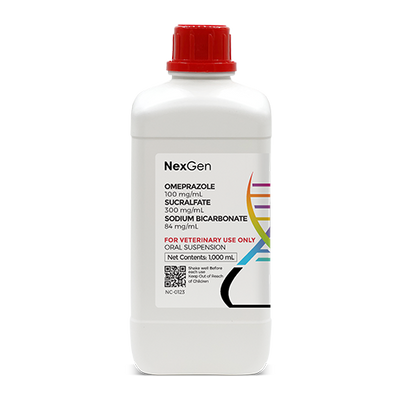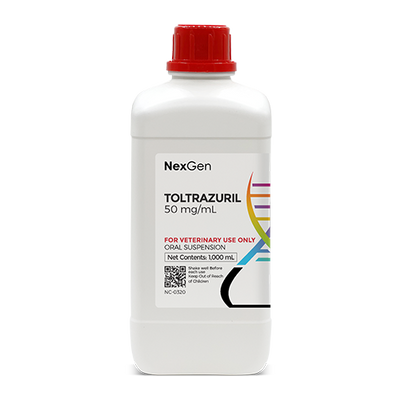
Sucralfate 300 mg/mL, Oral Suspension, (1000mL)
Login for pricing
- Brand
- Mixlab
- SKU:
- NC-0121
- Product Type:
- Suspension
- Size:
- 1000ml
- Administration:
- Oral
Sucralfate For Equine GI Ulcers
Equine gastric ulcer syndrome (EGUS) is often said to be one of the most misdiagnosed and mistreated conditions in equine medicine. This is interesting, given the advancements in diagnostic technology and veterinary medicine overall in recent years. Still, however, a definitive diagnosis of EGUS in any given horse often remains elusive until the animal’s overall health has been significantly compromised.
The word “gastritis” is the general term used to describe inflammation and/or irritation of the stomach lining, but this is actually a condition caused by an underlying disease process. Gastric ulcers are highly prevalent in horses, and result in decreased performance and loss of revenue. The prevalence of EGUS in domesticated horses is high, with its prevalence in performance horses (such as Thoroughbreds in race training) running as high as 70 to 94%.1
How Do Horses Wind Up With GI Ulcers?
A horse’s stomach lining consists of two different tissue types:
- The Squamous mucosa (which includes the top half of the horse’s stomach)
- The Glandular mucosa (which includes the bottom half of the stomach)
Ulcers can occur in either of these locations, but they are much more common in the squamous mucosa, which is similar to the lining of the esophagus. While the glandular mucosa contains acid-producing cells, most equine gastric ulcers affect the squamous mucosa.2 Exposure to excess acid is the principal mechanism responsible for squamous mucosal ulceration.
Gastric ulcers are sometimes accompanied by hindgut or colonic ulcers. While gastric ulcers are found in the stomach, colonic ulcers are lesions that occur in the hindgut. Horses are known as “hindgut fermenters.” This means that the horse ferments forage in its colon to create Volatile Fatty Acids which produce the majority of a horse’s energy. The risk for colonic ulcers is even greater in performance horses and those that are already suffering from gastric ulcers.2 As with gastric ulcers, colonic ulcers occur when the mucosal lining of the affected area is compromised.
Clinical Signs of Gastric Ulcers in the Horse
The clinical signs of EGUS in horses vary, and typically include anorexia and chronic or intermittent colic.1 “Many horses with endoscopic evidence of disease may appear to be clinically normal or have vague signs that include decreased consumption of concentrates, postprandial episodes of colic, poor performance or failure to train up to expectations, poor quality hair coat, and decreased condition or failure to thrive.”3 Diarrhea is not typically associated with gastric ulceration in horses, but can occur in cases of colonic ulcers.2
Although a diagnosis of EGUS can be suspected based upon clinical signs and response to treatment, the only current method of confirmation is via gastroscopy, which can easily be performed in the standing horse with mild sedation after a 12-18 hour fast.
Treatment of EGUS
Many treatments have been used for EGUS in horses. Since acid is the essential culprit in the case of squamous ulcer disease, most anti-ulcer therapy centers on decreasing gastric acid.1 The principal therapeutic options for ulcer treatment include H2 antagonists such as cimetidine, ranitidine and famotidine), proton pump inhibitors (or PPIs) such as omeprazole, pantoprazole and esomeprazole), and the mucosal adherent sucralfate.
Sucralfate has been widely used in treating ulcers affecting the glandular part of the stomach in horses. Its effects are local rather than systemic and it does not affect production of gastric acid. Sucralfate has often been used to treat oral, esophageal, gastric, and duodenal ulcers and to prevent drug (eg, aspirin)-induced gastric erosions.
After oral administration, sucralfate may react with hydrochloric acid in the stomach to form a paste-like complex that preferentially binds to the proteinaceous exudates that are generally found at ulcer sites. Sucralfate may have some cytoprotective effects, possibly by stimulation of prostaglandin E2 and I2. It also has some antacid activity, although this may not be of clinical importance. Sucralfate may also bind to intact GI mucosa to form a protective layer.4
Sucralfate is contraindicated in patients with known hypersensitivity to it, and has several drug interaction warnings. Because it may cause constipation, it should be used with caution in animals in which decreased GI transit times might be deleterious.3 Otherwise, no contraindications nor serious adverse effects have been reported.
Where to buy Sucralfate
Sucralfate is available in the U.S. through several pharmaceutical manufacturers and through veterinary custom compounding companies.
Please consult your veterinarian prior to beginning any treatment regimen.
FOR RX ONLY: A valid prescription from a licensed veterinarian is required for dispensing this medication.
1McClure SR, Glickman LT, Glickman NW. Prevalence of gastric ulcers in show horses. Journal of the American Veterinary Medical Association. 1999 Oct;215(8):1130-1133.
2Nadeau, J., et. al. Evaluation of diet as a cause of gastric ulcers in horses. AJVR, Vol 61, No. 7, July 2000.
3Murray MJ. Gastric ulceration in horses: 91 cases (1987-1990). Journal of the American Veterinary Medical Association. 1992 Jul;201(1):117-120.
5Videla R, Andrews FM. New perspectives in equine gastric ulcer syndrome. Vet Clin North Am Equine Pract. 2009;25(2):283-301.


















